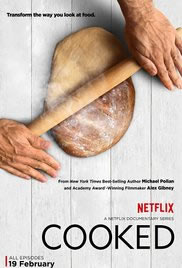On February 19, 2016, Netflix debuted a documentary series titled “Cooked,” which is based on journalist Michael Pollan’s 2013 book, Cooked: A Natural History of Transformation. The four-part series explores the various methods of cooking and their impact on humans and culture throughout history. Each episode focuses on a natural element (fire, water, air or earth), and its relationship with various cultures and foods.
In the third episode, titled “Air,” Pollan explores the science behind bread making and gluten, as well as the history of milling. The episode artistically shows the relationship between wheat and humankind, and how both have evolved throughout time (and industrialization). He also explores the evolution of bread making from Moroccan wheat fields, to food lab, to seed banks.
Pollan highlights changes in society’s perception of bread from something sacred to something we strive to avoid. Throughout time, additional ingredients have been added to bread, such as yeast, which have caused health concerns and increased negative perceptions of bread. Through the examination of the current bread making process, industrialized bakeries are shown in a negative light and are seen as the root of the cause for the reason people have become sick from breads. Overall, Pollan favors breads with minimal ingredients and additives.
The main purpose of this series is to encourage viewers to prepare home‐cooked meals, highlighting the benefits to our health and souls. The most relevant information and key takeaways for GFF from the special can be found below.
Relevant Information for the Grains Industry
- Wheat is the most widely planted crop in the world.
- With a growing world population wheat importation/exportation has become increasingly important and is often political.
- Bread making is a mix of three things: biology, cooking and physics.
- Bread is alive with bacteria before it is baked; once baked, the gluten in bread locks in the air and causes it to expand, giving bread its appealing texture and taste.
- Western culture goes through phases of avoiding food groups (i.e. fats in the 1970s, gluten today).
- Gluten intolerance has become a widespread trend, while only a small percentage of people have celiac disease.
- Recent trends have demonized gluten and bread with claims that they are bad for our health.
- Although little proof about gluten’s impact on the body, 30 percent of Americans avoid gluten.
- Traditional bread recipes have three ingredients, while manufactured bread sold in stores today often have 30 ingredients.
- Industrialized bread yielded white bread, which is nonperishable, cheaper and more widely available.
- White bread removes the nutritious part of grain, creating a new bread business.
- People started getting sick from white bread because of the several ingredients added in industrial breads, and instead of moving back to whole wheat, industrial bread makers started adding new vitamins, which created a new bread market.
- The art in bread making is perfecting fermentation; without fermentation, bread lacks nutrients.
- Fermentation has been industrialized with fast‐acting yeast and this has led to a higher incidence of bread intolerance
- Instead of eating gluten-free, consumers should eat fermented bread over yeast bread.
Additional Information
- Bread is a product of civilization and an enabler of civilization.
- Bread was discovered by accident 6,000 years ago in Egypt, when naturally occurring yeast developed in a bowl of wheat porridge, fermented and rose.
- Baking bread is an evolutionary advancement, making it possible for the human body to digest the nutrients.
- Bread is sacred in many cultures.
- As a filling, staple food, the cost of bread needs to be low to prevent civil unrest; spike in bread prices contributed to the Arab Spring and French Revolution.
- Climate change has increased droughts and decreased wheat production, causing scientists to develop seed banks and farmers to breed wheat strains tolerant of heat and drought.
Experts Featured
- Nathan Myhrvold, founder of The Cooking Lab and co‐author of Modernist Cuisine at Home Studies food science to advance the culinary arts. His team of scientists and chefs use scientific applications to create new styles of cooking. He is currently working on making a gluten-free bread that has the texture and taste of normal bread.
- Richard Bourdon, owner of Berkshire Mountain Bakery, makes sourdough bread with just three ingredients (wheat, water and salt) and believes the art of bread making is in the process of fermentation.
Conclusion
- It is noted that bread making is alchemy, which transforms basic ingredients and air into nutritious, delicious food.
- Pollan suggests that the current gluten sensitivity trend may actually be caused by modern day techniques, rather than gluten itself.

